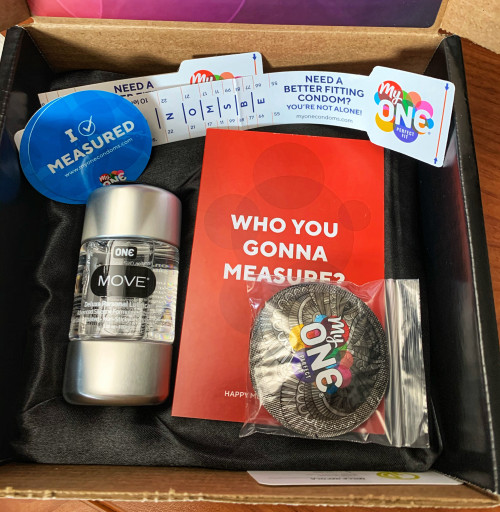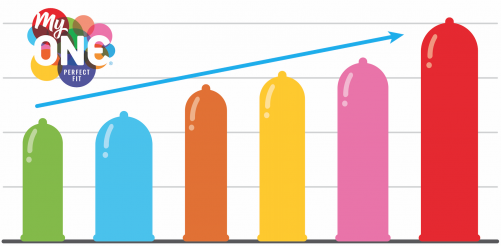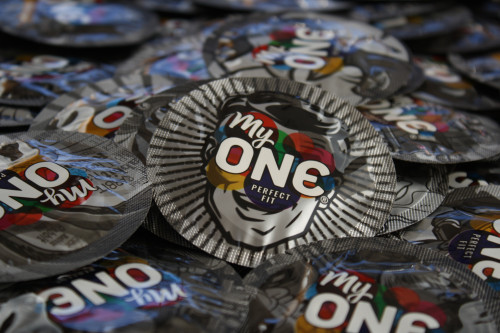So I return to my office after picking up lunch, and I find this mysterious box on my desk. Which is odd because I wasn’t expecting a delivery from Amazon or The RealReal (It’s a problem. I know.) The package, I figure, must be a promotional item of some sort.

Trenton Straube
I give it a closer look and discover that the box is from the ONE Shipping Department and includes a sticker that reads “My ONE Perfect Fit.” Rather cryptic, right?
But I’m actually aware of ONE products—in fact, I’ve used one or two in the past—so I have a hunch this’ll be a fun unveiling.

Trenton Straube
Indeed it is—and totally surprising. Who knew that February 1, 2020, marks the debut of Measure a Penis Day! Woot-woot! What an exciting way to kick off National Condom Month.
Inside the box, I find a collection of goodies, including two measuring tools, sample condoms, a bottle of ONE’s Move (a deluxe personal lubricant) and a few “I Measured” stickers.

Trenton Straube
But let’s back up. What does measuring your johnson have to do with rubbers or National Condom Month?

Courtesy of myONEcondoms.com
Simple: ONE condoms are available in 60 sizes, including 10 lengths and 9 widths. They’re called myONE Perfect Fit condoms, and they’re made with Sensatex latex and have silicone lubricant and a reservoir tip.
According to myONEcondoms.com, the rubbers sold in stores properly fit only 12% of condom users.
And to state the obvious: The better the fit, the better the f—ck.

Courtesy of myONEcondoms.com
How can you discover your perfect fit—aside from popping by my office? (JK.) Download a measuring kit at myONEcondoms.com, or use your own measuring tape. You’ll need to convert to millimeters, though, because they’re more accurate. (BTW: 1 inch equals 25.4 millimeters). The company also offers online help based on the condoms you generally use.
Once you know your length and width, you’ll be assigned a corresponding code. Then you’re ready to order.

Courtesy of myONEcondoms.com
What about price? For a one-time order, it’s $10 for a 6-pack; $15 for a 12-pack and $20 for a 24-pack. The packs generally run a few dollars less if you sign up for regular delivery (every one, two or three months). The company also sells four different types of lube.

Courtesy of myONEcondoms.com
While we’re on the topic of condoms, just how well do they prevent HIV? In general, the Centers for Disease Control and Prevention (CDC) says “consistent and correct use of latex condoms is highly effective at preventing the sexual transmission of HIV.”
As for the sexually transmitted infections (STIs, also called STDs) that are spread via genital fluids—this includes gonorrhea, chlamydia and trichomoniasis—condom use reduces the risk of contracting these STIs. What about other types of STIs? Consistent and correct use of latex condoms reduces the risk of getting an STI like syphilis, genital herpes and chancroid only when the infected area and potential site of exposure are protected by the latex condom. What’s more, condoms “may reduce” the risk of genital human papillomavirus (HPV).
What about preventing pregnancy? Here’s an entire graph about that from the CDC:
Latex condoms, the most common type, help prevent pregnancy, and HIV and other STDs, as do the newer synthetic condoms. “Natural” or “lambskin” condoms also help prevent pregnancy, but may not provide protection against STDs, including HIV. Typical use failure rate: 13%. Condoms can only be used once. You can buy condoms, K-Y Jelly, or water-based lubricants at a drugstore. Do not use oil-based lubricants such as massage oils, baby oil, lotions, or petroleum jelly with latex condoms. They will weaken the condom, causing it to tear or break.
And here’s what Planned Parenthood has to say:
If you use condoms perfectly every single time you have sex, they’re 98% effective at preventing pregnancy. But people aren’t perfect, so in real life condoms are about 85% effective—that means about 15 out of 100 people who use condoms as their only birth control method will get pregnant each year.
But back to HIV. Here’s more CDC data on HIV and condoms: Based on self-reporting, condoms reduce the acquisition of HIV by 80% between heterosexual men and women; by 72% to 91% for HIV-negative gay men having receptive anal sex (that is, they’re they bottom); 63% for the gay men having insertive anal sex (tops). Overall, these numbers may be an underestimate of true effectiveness, the CDC says, adding that “condom effectiveness is likely to be higher when condoms are used correctly every time during sex.”
And about proper condom use…we could all use a refresher, right? Check out this video from the American Sexual Health Association’s website, which notes that condoms are the only prophylaxis that reduces the risk of both STIs and pregnancy.
In light of all this information, you can see how a properly fitting condom can do more than increase your pleasure—it can increase your protection.
Happy shopping!

Trenton Straube
While I have your attention, you might want to check out the article “It’s High Time to Redefine ‘Safe Sex’” by my colleague Benjamin Ryan. Ben points out that “in the era of HIV treatment as prevention and PrEP, condomless sex doesn’t carry the same risk it once did.”
Not familiar with PrEP and treatment as prevention or the fact that undetectable equals untransmittable? Then read my article “How Well Do U=U and PrEP Work? The CDC Updates Its Answers.”








2 Comments
2 Comments